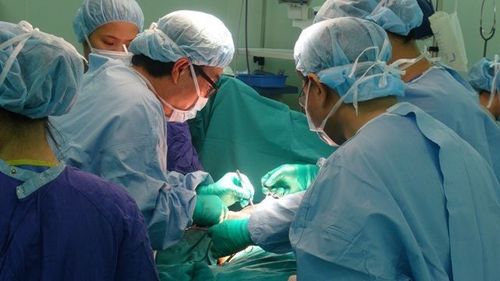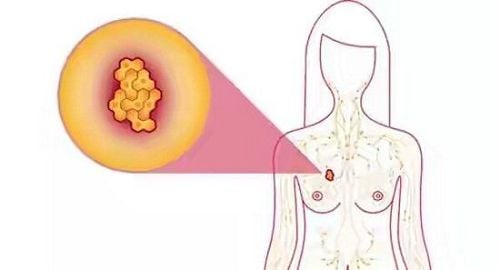This is an automatically translated article.
The article was written by Specialist Doctor I Nguyen Thi Minh Thuyen - Pathologist, Pathology Department - Vinmec Danang International General Hospital.Your doctor will determine breast cancer treatment options based on the type of breast cancer, the stage and histology of the disease, the size of the tumor and whether the cancer cells are hormone-sensitive, your health overall and individual patient status.
1. Choosing breast cancer treatment methods
Most breast cancer patients have surgery and also receive additional treatment after surgery, such as chemotherapy, hormone therapy, or radiation therapy. Chemotherapy may also be prescribed before surgery in some situations.There are many treatment options for breast cancer and it can feel overwhelming to make complex decisions about treatment. Consider getting a second opinion from a breast specialist in a breast center or clinic. Talk to other women who have faced similar decisions.
Trắc nghiệm: Những lầm tưởng và sự thật về ung thư vú
Ung thư vú có tỷ lệ tử vong cao nhất ở nữ giới khiến họ rất lo sợ bản thân mắc phải căn bệnh này. Tuy nhiên, không ít chị em có những hiểu biết thái quá về ung thư vú. Thử sức cùng bài trắc nghiệm sau sẽ giúp bạn loại bỏ được những nghi ngờ không đúng về căn bệnh này.
Bài dịch từ: webmd.com
2. Breast cancer surgery
2.1 Types of surgery for breast cancer
Breast cancer surgery includes:
Removal of breast cancer (tumourectomy): Called breast-conserving surgery or extensive lumpectomy, the surgeon removes the tumor and a small margin of surrounding healthy tissue. Tumor resection: May be an option to remove smaller tumors. Some people with larger tumors may receive chemotherapy before surgery to shrink the tumor and possibly remove it completely. Removal of the entire breast (mastectomy, mastectomy): A total mastectomy is the removal of all of your breast tissue. Most mastectomy removes all of the breast tissue - the lobules, ducts, fatty tissue, and breast skin, including the nipple and areola (total or simple mastectomy). Newer surgical methods may be selected in some cases to improve the shape of the breast. Skin-sparing mastectomy and nipple-sparing mastectomy are increasingly popular options. Limited lymph node removal (sentinel lymph node biopsy): To determine if cancer has spread to the lymph nodes, your surgeon will discuss the role of removal with you. The lymph nodes first receive lymphatic drainage from the breast tumor. If no cancer is found in those lymph nodes, the chances of cancer being found in the remaining lymph nodes are low, so there is no need to remove the other nodes. Lymph node removal (axillary lymph node dissection): If cancer is found in sentinel lymph nodes, your surgeon will discuss with you the role of lymph node removal in the armpit area. Removal of both breasts: Some women with cancer in one breast may choose to have the other (healthy) breast removed (contralateral prophylactic mastectomy) if they are at very high risk for cancer. cancer in the other breast due to a genetic predisposition or a clear family history. Most women with cancer in one breast will not have cancer in the other breast. Discuss your breast cancer risk with your doctor, along with its benefits and risks.

2.2 Complications of breast cancer surgery
Complications of breast cancer surgery depend on the methods you choose. Breast cancer surgery carries a risk of pain, bleeding, wound infection, and swelling of the arm (lymphedema).You can choose to have breast reconstruction after surgery. Discuss your options with your doctor. Consider seeing a plastic surgeon before having breast cancer surgery. Options may include reconstruction using breast implants (silicone or water) or reconstruction using your own tissue. These methods can be performed at the time of a mastectomy or after.
3. Radiation therapy for breast cancer
Radiation therapy uses high-energy beams, such as X-rays and protons, to kill cancer cells. Radiation therapy is usually given using a large machine that targets energy beams in the body (external radiation). These radiations can also be given by placing radioactive material inside the body (internal radiation).
External radiation to the whole breast is usually indicated after lumpectomy. Internal radiation may be an option after a lumpectomy if you have a low risk of breast cancer coming back.
Doctors may also recommend radiation therapy to the chest wall after mastectomy (removal of the entire breast) for larger tumors or cancer that has spread to the lymph nodes. Breast cancer radiation can last from three days to six weeks, depending on the treatment. A doctor who uses radiation to treat cancer (radiotherapy) determines which treatment is best based on the condition of the disease, the type of cancer, and the location of the tumor.
Side effects of radiation therapy include fatigue, skin redness, and darkening of the skin. Breast tissue may also become swollen or stiffer. More serious effects may occur, such as damage to the heart or lungs or, more rarely, a second cancer in the treated area.
4. Chemotherapy for breast cancer
Chemotherapy uses drugs to kill fast-growing cells, such as cancer cells. If the cancer is at high risk of coming back or spreading to other organs, your doctor may recommend chemotherapy after surgery to reduce the chance of a recurrence. Chemotherapy is sometimes indicated before surgery in women with larger breast tumors. The goal is to shrink the tumor to make it easier to remove surgically.Chemotherapy is also used in cancers that have spread to other parts of the body. Chemotherapy is recommended to try to control the cancer and reduce any symptoms the cancer is causing.
Side effects of chemotherapy depend on the drug. Common side effects include hair loss, nausea, vomiting, fatigue, and an increased risk of infection. Rare side effects include early menopause, infertility (if premenopausal), heart and kidney damage, nerve damage, and, rarely, blood cancer.

5. Hormone therapy for breast cancer
Hormone therapy - perhaps more properly called hormone-blocking therapy - is used to treat hormone-sensitive breast cancer. Doctors call these cancers estrogen receptor-positive (ER-positive) and progesterone receptor-positive (PR-positive) cancers.Hormone therapy can be given before or after surgery or other treatments to reduce the risk of the cancer coming back. If the cancer has spread, hormone therapy can help control and shrink them.
Hormone therapy includes:
Medications that block hormones from attaching to cancer cells Drugs that stop the body from producing estrogen after menopause (aromatase inhibitors) Surgery or medication to stop hormone production in the ovaries Eggs Side effects of hormone therapy depend on the specific treatment, but can include hot flashes, night sweats, and vaginal dryness. More serious side effects include an increased risk of osteoporosis and blood clots.
6. Targeted medicine
Targeted drug therapy targets specific malignant cells. For example, some targeted drugs target a protein that some breast cancer cells overproduce called human epidermal growth factor receptor 2 (HER2).Protein helps breast cancer cells grow and survive. By targeting cells that make too much HER2, the drug can destroy cancer cells while keeping healthy cells intact.
Targeted drug therapy that focuses on other abnormalities in preexisting cancer cells. And targeted therapy is a big area in cancer research.
You will be tested to see if you could benefit from targeted therapy drugs. Certain medications are used after surgery to reduce the risk of the cancer coming back. Others are used in cases of advanced breast cancer to slow tumor growth.
7. Immunotherapy
Immunotherapy is the use of the immune system to fight cancer. The disease-fighting immune system in your body may not attack the cancer because the cancer cells make proteins that blind the immune system cells. Immunotherapy is indicated by interfering with that process.Immunotherapy may be an option if you have triple-negative breast cancer, which means the cancer cells don't have receptors for estrogen, progesterone or HER2. For triple-negative breast cancer, immunotherapy is combined with chemotherapy to treat advanced cancer that has spread to other parts of the body.

8. Supportive care (palliative)
Palliative care is specialized medical care that focuses on relieving pain and other serious illness symptoms. Palliative care professionals work with you, your family and other doctors to provide additional support to your continuum of care.Palliative care can take place concurrently while undergoing other aggressive treatments, such as surgery, chemotherapy, or radiation.
When palliative care is taken along with all other appropriate treatments, people with cancer can feel better and live longer. The palliative care team is made up of doctors, nurses, and other specially trained professionals. The supportive palliative care team aims to improve the quality of life for people with cancer and their families.
At Vinmec International General Hospital, there is a Breast Cancer Screening Package to help detect breast cancer early even when there are no symptoms.
Breast cancer screening package at Vinmec for the following subjects:
Female customers, over 40 years old. Customers wishing to be able to screen for breast cancer Customers are at high risk of cancer – especially customers with a family history of breast cancer. Women of reproductive age, perimenopause and menopause. Women are showing symptoms of breast cancer such as: pain in the breast, lump in the breast, etc. >> See also: Rehabilitation exercises after breast cancer treatment - Article by Master Vu Van Minh - Chief technician at the Department of Rehabilitation - Vinmec Times City International General Hospital
Please dial HOTLINE for more information or register for an appointment HERE. Download MyVinmec app to make appointments faster and to manage your bookings easily.
Article referenced source: American Cancer Society













